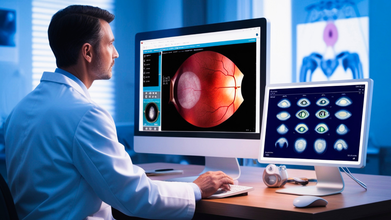- Health Conditions A-Z
- Health & Wellness
- Nutrition
- Fitness
- Health News
- Ayurveda
- Videos
- Medicine A-Z
- Parenting
- Web Stories
After A 20-Year Old Woman's Nut Allergy Got Triggered After Sex, Doctors Revealed Shocking Diagnosis

Image Credit: Canva
A romantic evening turned into a nightmare for a 20-year-old woman in the UK when she developed a severe allergic reaction after sex. She hadn't eaten anything out of the ordinary, but within minutes, her body broke out in hives, her skin swelled, and breathing was labored. The culprit? Her partner had eaten Brazil nuts a few hours before. Despite showering and brushing his teeth, traces of the allergen found its way into his semen and triggering a dangerous reaction. This unusual medical incident raises important questions regarding hidden allergy threats, pushing physicians to question how food proteins can be transmitted in the most unusual means.
In the field of emergency medicine, physicians are used to odd and puzzling cases. Nevertheless, this case left physicians stunned. The patient, who was known to be allergic to Brazil nuts, developed a severe allergic reaction after unprotected vaginal sex with her regular male partner. What made this case so confusing was that her partner had showered, brushed his teeth, and washed his nails thoroughly after eating Brazil nuts—yet she still developed a severe allergic reaction.
Shortly after intercourse, the woman began experiencing intense itching and swelling in her vulva and vagina. The symptoms quickly escalated to angioedema—severe swelling beneath the skin—and hives spreading across her body. Within minutes, she felt faint and short of breath, prompting an immediate visit to the emergency room.
When they arrived, the ER staff gave her 10 milligrams of cetirizine, an oral antihistamine used to alleviate allergies and hives. Because of her history of severe allergies to nuts, medical professionals were intent on identifying the source of her reaction. But her partner's meticulous cleanliness precautions should have left no trace of allergen behind. The question remained: how could a potentially fatal allergic reaction be provoked with such precautions in place?
Physicians then started investigating whether allergens entered the patient's body in a non-traditional manner. Based on her background of allergy to Brazil nuts and the timeline of symptoms, experts speculated that allergenic Brazil nut proteins were transmitted through her partner's semen.
To try out this theory, a sequence of skin prick tests was administered with semen samples from her partner. One was taken when the man hadn't eaten nuts recently, and another two and a half hours later when he had eaten Brazil nuts. The findings were dramatic—the patient developed a 7-millimeter welt when subjected to the second sample, clearly indicating that proteins from Brazil nuts had found their way into her body via semen and provoked the reaction.
How Allergens Spread Through the Body
This case highlights a less common mechanism of allergen transfer. It is known that allergens can be transferred by direct contact, for example, touching or kissing. But this was the first reported case where a systemic allergic response was induced through seminal fluid.
Brazil nuts harbor a very allergenic protein called 2S albumin, which has been recognized as one of the primary culprits in severe allergic reactions. What makes this protein so dangerous is that it can withstand digestion in the human gastrointestinal system, enabling it to be absorbed into the bloodstream and travel throughout the body. It is suspected that once ingested, the protein was absorbed into the blood, traveled to the reproductive organs, and was secreted into semen. This discovery implies that other allergens in foods could also be capable of traveling via seminal fluid and inducing allergic reactions in susceptible individuals.
Management of Risk of Semen-Transferred Allergens
Due to the life-threatening risk of this form of allergic reaction, doctors recommended that the patient take strict measures in the future. The guidelines were:
Not engaging in sexual intimacy if her partner had just eaten Brazil nuts or other allergens.
Having antihistamines and an auto-injector of adrenaline (EpiPen) on hand in case future allergic reactions were to happen.
Seeing an allergist to consider other preventative measures, including what dietary changes may be recommended for her partner.
There is also cause for concern with anyone who has serious food allergies that are sexually active. Though a rare possibility, the same might happen with any of the typical allergens like dairy, shellfish, or peanuts.
Studies have already documented cases where allergens caused reactions through indirect contact, such as kissing or touching. However, seminally transferred food proteins present a unique challenge for allergists and immunologists. Further research could help determine how common this occurrence is and what preventive strategies should be recommended for individuals with life-threatening food allergies.
Though the couple in this case eventually parted ways, the knowledge discovered from their encounter has had a long-lasting influence on allergy medicine. It is a truly inspiring illustration of how the most mundane elements of life—physical intimacy, for example—can pose unforeseen medical complications. If more is known and alerted to through continued research, physicians intend to create enhanced protections for people with severe allergies against sudden and potentially deadly reactions.
Heart Diseases Risk and Aging Health Issues Could Be Predicted By A Simple Eye Scan: Study Showed 70% Accuracy

(Credit-Canva)
Heart diseases are one of the most common issues people face in the world. Despite being the leading cause of death globally, according to the world health organization, many people miss critical signs of it. The best way to ensure a person gets treatment, is that the disease must be diagnosed in its early stages. A new study suggests diagnosing the risk of heart disease early is also possible, with the help of eye scans.
Researchers at McMaster University and the Population Health Research Institute (PHRI) have made an incredible discovery. They found that the tiny blood vessels in your eyes could be a powerful way to guess how likely you are to develop heart disease and how fast your body is truly aging on the inside. This is a big deal because right now, checking for these risks involves many complicated tests.
The study, which was published in the journal Science Advances, suggests that soon, doctors might be able to use a simple scan of your retina, which is the back of your eye, as a quick and non-invasive tool. This scan could show them the overall health of your blood circulation and reveal your body’s real biological age. This new method could open up amazing possibilities for catching serious health issues much earlier.
Can You Diagnose Heart Diseases From Eye Scan?
The study was massive, involving over 74,000 people from large international research groups. The scientists analyzed their retinal images, genetic makeup, and blood data.
Their key discovery was striking, people whose blood vessels in the retina were simpler and looked less branched (not as tree-like) were found to be at a higher risk for heart problems. These same people also showed clear signs of faster biological aging, meaning they had more inflammation in their bodies and a potentially shorter life expectancy.
Dr. Marie Pigeyre, one of the main researchers on the study, explains that the eye is unique. It gives doctors a special, clear, and easy way to look at your entire circulatory system—all the veins and arteries that carry blood throughout your body.
Mirroring the Body
Think of the eye's small blood vessels like a mirror. Changes happening in these vessels reflect the same changes happening in the small blood vessels everywhere else in your body. If the vessels in your eye look unhealthy, chances are, the vessels around your heart and brain are also struggling.
Molecular Clues
The team didn't just look at pictures. By combining the retinal scans with genetic information and blood test results, they were able to uncover specific "molecular pathways." These are basically the biological rules or processes that explain exactly how aging causes problems in your blood vessel system.
Can You Cure Genetic Heart Diseases?
The researchers went beyond just finding a link; they used the blood and genetic data to hunt for the root causes of these eye vessel changes. This led them to pinpoint specific proteins that appear to be the main drivers of both aging and disease.
They identified two major proteins: MMP12 and IgG–Fc receptor IIb. Both of these are strongly linked to inflammation and the deterioration of blood vessels as we age.
Dr. Pigeyre is excited because these specific proteins could become targets for new drugs. Medicines designed to control or slow down these proteins could help reduce the impact of vascular aging, lower the risk of heart disease, and ultimately help people live longer and healthier lives.
Right now, to check for serious age-related diseases like heart disease, stroke, and memory problems (dementia), doctors have to perform many different tests. The big hope is that a quick, simple retinal scan could one day become an easy-to-access tool to immediately check a person's risk for heart problems and determine their biological age.
Ask These 3 Questions To Your GP To Avoid Being Misdiagnosed, According To Doctor

(Credit-Canva)
It is not uncommon for women’s health concerns to be overlooked even by professionals. Often chalking up their health issues as, ‘common women ailments’, many healthcare professionals, miss the core reason for women’s symptoms. In a recent video, Dr Karan Rajan, an NHS Surgeon, shared a video, explaining how often, even signs of chronic illnesses can get overlooked as just ‘anxiety’.
So, is there no way a person can ensure they have the right diagnosis? In the video Dr Karan listed a few ways one can ensure they have the right diagnosis, from asking the right questions and how to proficiently communicate your symptoms to the doctor.
What Questions Should You Ask Your Doctor?
If your doctor told you that your health problems are "just anxiety," remember that you have the right to push for a more thorough checkup. One should ask the right questions as it is their health on the line. Being ready shows you're serious and ensures your doctor looks into your condition properly.
Dr. Karan explains that when talking to your doctor, you should ask questions that make them explain why they settled on an anxiety diagnosis. This shifts the focus back to the doctor, requiring them to justify their medical opinion. Here are the key questions you should use.
"What tests have been done to rule out other causes of my symptoms?"
This question is powerful because it makes the doctor list exactly what they have investigated. It clarifies the boundaries of the investigation. If the doctor hasn't run many tests, you know there's more ground to cover.
"Can you explain why you think this is anxiety and not a physical medical condition?"
Don't accept "your blood work is fine" as the only answer. That's often not enough. Many serious health conditions don't show up on a routine blood test. You want a detailed explanation of their thinking, not just a quick dismissal.
"Have we ruled out other conditions that can look exactly like anxiety?"
It's surprising how many physical illnesses have symptoms that are identical to anxiety. Dr Karan explains how thyroid problems like hypothyroidism, issues with your nervous system like dysautonomia, or even an immune disorder like mast cell activation syndrome, can all cause symptoms like a racing heart, dizziness, or panic. You want to be sure these possibilities have been considered.
Is It Anxiety Or A Health Condition?
If your doctor only suggests things like talk therapy and certain medications (like SSRIs), be prepared to ask for more. You need to know if they're looking at the big picture.
Dr Karan suggests that you should ask them: "What treatment plan would you suggest that goes beyond just treating the anxiety itself?"
If their only answer is medication and counseling, it's fair to ask what other medical routes or specialists can be explored to find the root cause of your symptoms.
How Should You Describe Your Symptoms?
When describing your symptoms, you need to be precise and give the doctor hard data. This makes it much harder for them to brush off your concerns as simple stress. Dr Karan gives an example, instead of just saying, "I get dizzy a lot," get into the details:
"I get dizzy when I stand up, especially in the morning. It's worse after eating or after I’ve been sitting for a long period of time."
This kind of specific detail is very important. Symptoms that happen when you stand up and improve when you lie down could point to a physical problem like Postural Orthostatic Tachycardia Syndrome (POTS), not just everyday anxiety.
The clearer and more factual you are, the less likely they are to dismiss your condition as just "generalized stress." Dr. Rajan emphasizes that "data talks." Start keeping a symptom diary right away! It's an essential tool for tracking your condition every day. In your log, record:
The exact time symptoms happened.
What you ate or drank beforehand.
What made the symptoms better or worse.
Look for patterns. Does the dizziness only happen after you stand up? Do your symptoms worsen after a certain meal, or around your sleep schedule, or with hormonal changes? Bringing this detailed log, to your appointment makes it much, much more difficult for any doctor to doubt or dismiss your concerns.
Think You’re Safe Indoors? Study Says Delhi’s Winter Pollution Follows You Home

Credits: Canva
With Delhi winters coming in, the spell of late smog is most likely to stay not just outside the homes, but it could in fact, follow you inside your homes. A study by the University of Delhi's Satyawati College, Jamia Millia Islamia, and US's South Dakota University, reveal that bacterial levels were recorded to be 10 fold higher than the World Health Organization (WHO) recommended safety limits.
Studies have also found that air inside the city homes have 12 times more fungal spokes than the WHO safety limits. They can cause skin allergies, respiratory issues, and anxiety. As per a 2021 study by the Energy Policy Institute at the University of Chicago (EPIC India), PM 2.5 levels for low-income and high-income households in Delhi were high during the winters. The concentrations reported 23 and 29 times higher than the WHO safe limits, respectively. These findings also suggested that high-income households were 13 times more likely to own air purifiers than low-income households.
In Delhi, No One Gets To Breathe
Dr Kenneth Lee, who was the lead author of the study said, "In Delhi, the bottom line is - whether someone is rich or poor, no one gets to breathe clean air."
Lee further adds, "It’s a complex vicious cycle. When you do not know about the pollution levels inside your homes, you do not worry about it, and hence you are less likely to take corrective actions. Only with increased awareness, demand for clean air may gain momentum.”
The study also found that indoor PM2.5 levels were higher than the value reported by the nearest government monitor. The PM2.5 levels spiked in the mornings and evenings when households were most likely to be cooking.
The recent study published in Frontiers in Public Health 2025 notes that long term exposure to high fungal and bacterial concentration make indoor air in several parts of Delhi as harmful as the smog outside. The study also noted that most fungal particles were smaller than 2.5 microns, this is why they can easily penetrate through your bloodstreams.
The study revealed a distinct seasonal trend in indoor air quality across Delhi. Fungal levels rose steadily from winter, peaking at around 6,050 CFU per cubic metre between September and November, just before the city’s infamous smog season. Bacterial concentrations, meanwhile, climbed from winter to summer, reaching their highest levels in August before tapering off in the fall.
Health complaints among residents were widespread: 33% reported frequent headaches, 23% experienced burning or irritated eyes, 22% suffered persistent coughing or breathlessness, and 18% struggled with sneezing and allergic rhinitis. Another 15% reported skin irritation and itching.
Who Are At Most Risk Of Indoor Pollution?
The study highlighted that children and young adults were particularly vulnerable, about 28% of children under 12 and 25% of young adults (18–30 years) experienced breathing difficulties, coughing, or allergy-related symptoms. Researchers attributed children’s higher susceptibility to developing lungs, increased physical activity, and longer indoor exposure.
Women also reported more eye and skin problems, making up nearly 60% of dermatological and eye irritation cases, likely due to spending more time indoors.
Conducted over a year in North Delhi, the study, “Microbial Indoor Air Quality Assessment and Health Correlations in Densely Populated Urban Areas of Delhi, India”, found that fungal and bacterial levels inside homes were several times higher than WHO’s safe limits, underscoring that Delhi’s pollution crisis extends well beyond outdoor air.
© 2024 Bennett, Coleman & Company Limited

